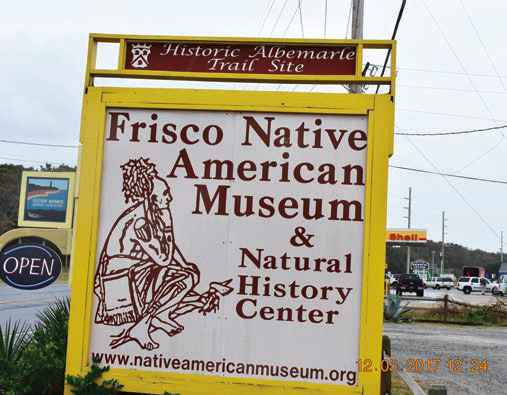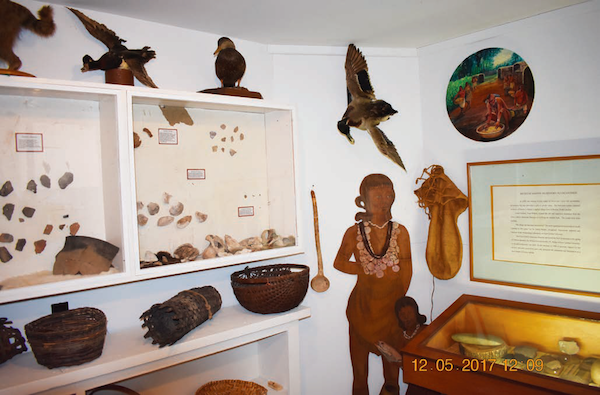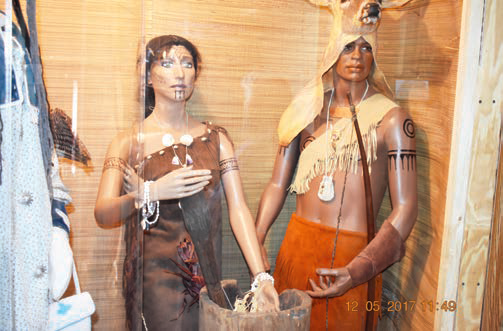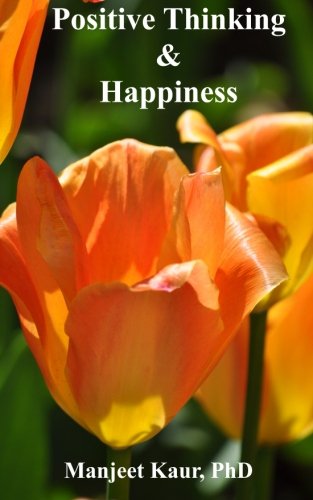

In the museum there are many displays which show the way of life for Native Americans. Displays like; art work, pictures of animals, weapon and combat, natives and food, dresses, police and peace medals, pottery, code talkers, weaving, canoes and kayaks and much more. There is a gift shop in the museum which is called, Now Natural History Center. It features work from over 30 Native American artists and from where you can buy unique handmade crafts. They ship all over the world. There is a natural trail in the facility too.
Frisco Native American Museum & History Center is a nonprofit educational foundation created for the purpose of preserving Native American artifacts, art, culture, and language.
It can also teach people about native perspective and how to treat the Earth, said MS Ronnie Francisco, Assistant director of the museum. This Museum is located on Hatters Island on the Outer Banks of North Carolina.


 When you enter the museum, the message is on the wall in the shape of a poster entitled “The Earth on Turtle’s Back”. Many Native Americans refer to North America as Turtle Island,which comes from the belief that all of the Earth was water until a large
When you enter the museum, the message is on the wall in the shape of a poster entitled “The Earth on Turtle’s Back”. Many Native Americans refer to North America as Turtle Island,which comes from the belief that all of the Earth was water until a large
turtle emerged to support plant and animal life on its back. This teaching tells us, “where Turtle goes, there is life and water is precious”. Since we are dependent upon the earth, we must treat our ‘Island’ home with respect and honor all of the beings in the natural world. As you walk among the exhibits, look for teachings from “Turtle Island “indicated by the turtle symbol.

 According to MS Ronnie, the museum had its beginning over seventy years ago. It started in the heart of museum founder, Carl Bornfriend,when he was just a young boy. When many people did not realize the importance of preserving native artifacts, Carl frequently saw beautiful items carelessly treated. Though his own resources were limited, he often made sacrifices to become a keeper of the heritage. When Carl moved to Hatters Island he met Joyce and they discovered a mutual love for historical preservation. They married in 1986, and they brought more than a half century of experience as educators to the task of creating the museum, MS Ronnie said. Carl was a full-time teacher; but, he used every spare moment developing exhibits. He opened the museum in 1987 as a non-profit educational foundation.
According to MS Ronnie, the museum had its beginning over seventy years ago. It started in the heart of museum founder, Carl Bornfriend,when he was just a young boy. When many people did not realize the importance of preserving native artifacts, Carl frequently saw beautiful items carelessly treated. Though his own resources were limited, he often made sacrifices to become a keeper of the heritage. When Carl moved to Hatters Island he met Joyce and they discovered a mutual love for historical preservation. They married in 1986, and they brought more than a half century of experience as educators to the task of creating the museum, MS Ronnie said. Carl was a full-time teacher; but, he used every spare moment developing exhibits. He opened the museum in 1987 as a non-profit educational foundation.
MS Amber Roth of the museum said, “We have a lot of visitors that say we have a completely different feel. Instead of it being a very sterile, far away from you feel, the culture feels more alive.

 When you are here, you can reach out and feel that you are being embraced with it and from it. Rather than it just being distancing over here and not really there anymore.We bring more culture to life.”
When you are here, you can reach out and feel that you are being embraced with it and from it. Rather than it just being distancing over here and not really there anymore.We bring more culture to life.”
In the museum there are many displays which show the way of life for Native Americans. Displays like; art work, pictures of animals, weapon and combat, natives and food, dresses, police and peace medals, pottery, code talkers, weaving, canoes and kayaks and much more. There is a gift shop in the museum which is called, Now Natural History Center. It features work from over 30 Native American artists and from where you can buy unique handmade crafts. They ship all over the world. There is a natural trail in the facility too.
The earlier inhabitants of the North Carolina Outer Banks were Hatters Indians tribe of Native Americans.
(The author is Chesapeake VA based journalist. He can be reached at sdhillon@hotmail.com)





Be the first to comment